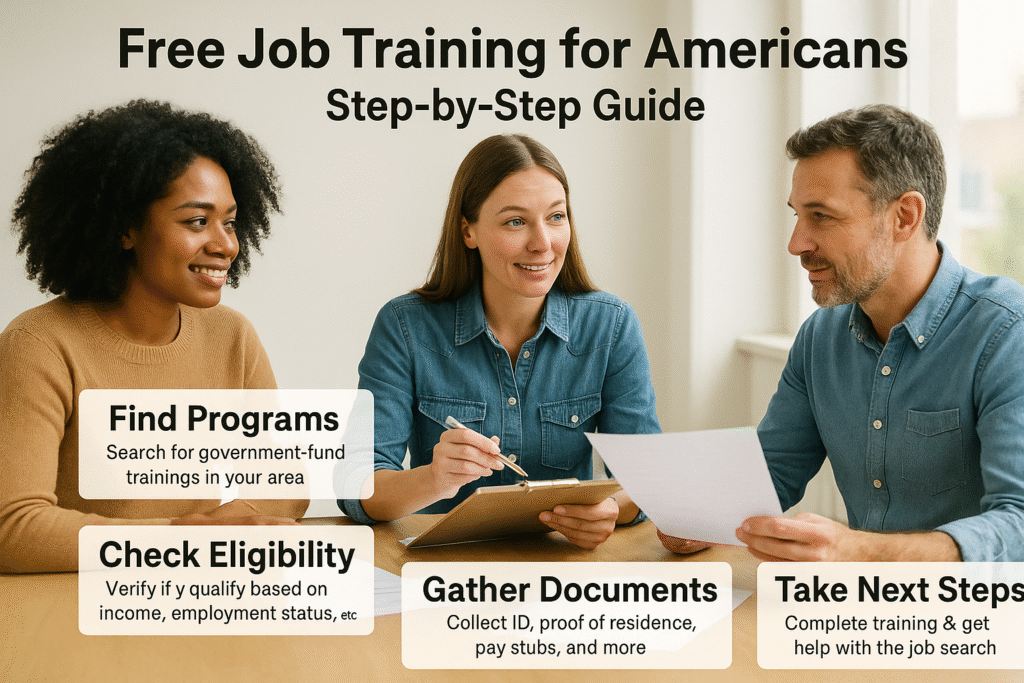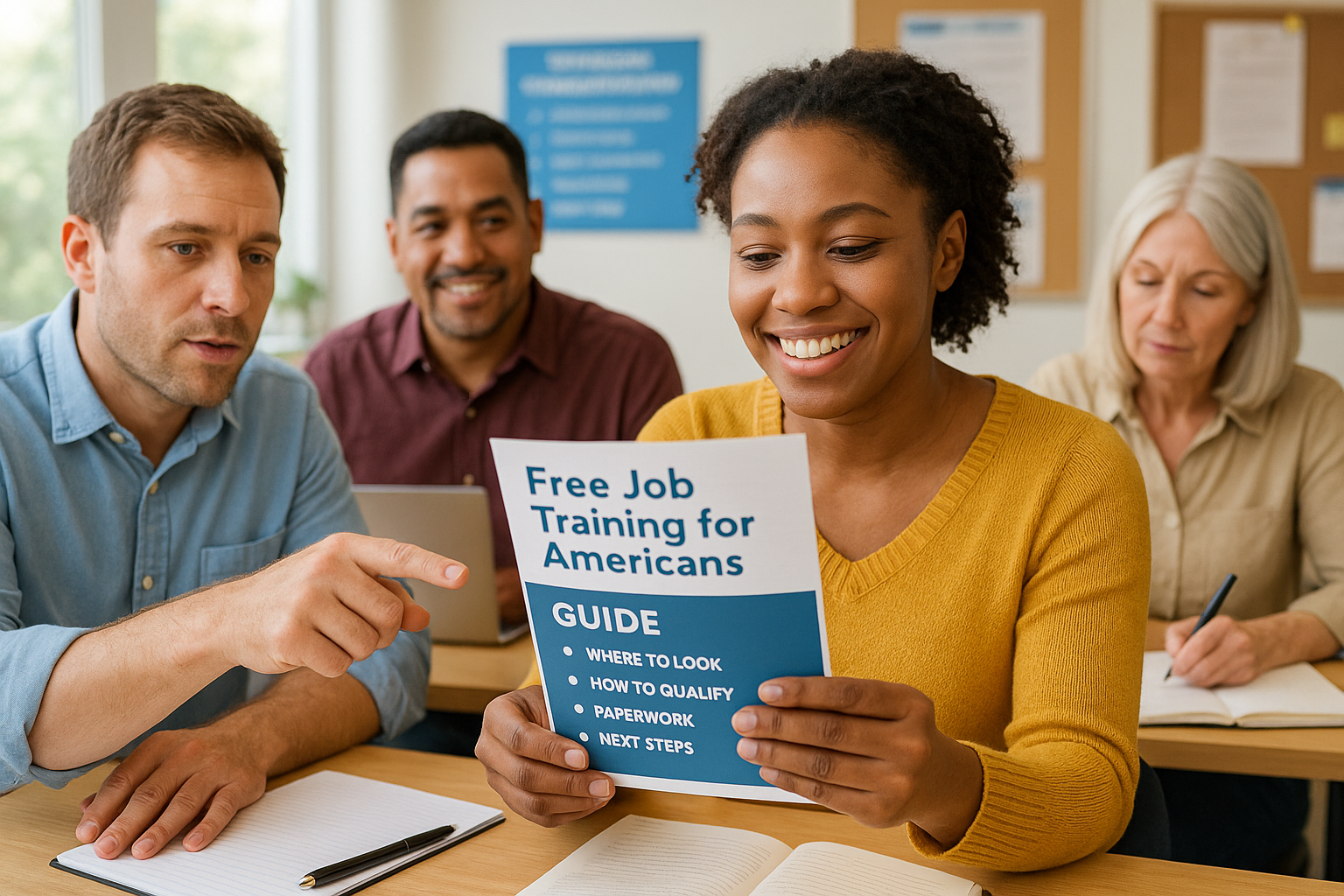Free Job Training for Americans: Looking for free or low-cost training that leads to real jobs? Great — there are lots of federal, state, and local programs built to help Americans learn skills employers want. This clear, action-oriented guide shows you where to look, how to qualify, what paperwork you’ll need, and next steps to turn training into work.
Why use official training programs first
Find Free Job Training for Americans — Step-by-Step Guide: Government-funded programs are usually free or heavily subsidized, connect you to employers, and often include job search support, certifications, or apprenticeships employers recognize. Start with official portals so you don’t waste time on low-quality offers.
Step 1 — Find state-run training near you (fast)
Most states run job training through their state labor or workforce agencies. These offices fund local classes, apprenticeships, and short-term training for in-demand fields. Search your state labor department’s website (USA.gov lists state links) or call your state workforce hotline to get the current openings and eligibility rules.
Quick action: Google “[Your State] workforce training” + your county name — then call the number on the state page and ask for the next available enrollment dates.
Step 2 — Use CareerOneStop — the Department of Labor hub
CareerOneStop (run by the U.S. Department of Labor) collects training, local program listings, resume help, and funding options in one place. Use the site’s Local Training Finder, occupation pages, and “Find Training” tools to search by career, location, or credential. CareerOneStop also links to apprenticeships and on-the-job training that pay while you learn.
Tip: save the training program code or provider name from CareerOneStop — you’ll need it when you ask your state office about funding or eligibility.
Step 3 — Explore federal youth and special-group programs
If you’re 16–24 and low-income, check Job Corps — a national, residential program with free career training and job placement in fields like health, construction, and IT. Veterans, people with disabilities, Native Americans, and TANF recipients also have tailored training programs through federal partners; CareerOneStop and USA.gov list these paths.
Who to contact: your local American Job Center (One-Stop) — they coordinate many special programs and help with applications.
Step 4 — Apprenticeships & on-the-job training — get paid while you learn
Apprenticeships and employer-sponsored on-the-job training (OJT) let you earn wages while gaining skills and a credential. Many states and employers offer tuition or wage subsidies to employers who train new hires — so apprenticeships are often free to the trainee and lead directly to work. Search apprenticeships on CareerOneStop and ask American Job Centers about OJT openings.
Quick pitch to employers (script): “I’m interested in an apprenticeship or OJT. Do you have openings or can your company work with the state workforce office for training funds?”

Step 5 — Find short-term credential programs and local providers
Use the Local Training Finder on CareerOneStop and TrainingProviderResults.gov to locate short, in-demand programs (e.g., HVAC, CDL, IT bootcamps) near you. These listings show program length, credentials, and whether employers hire graduates. Many community colleges also run free or grant-funded cohorts — contact their workforce or continuing education office.
Pro tip: ask whether the program connects graduates with hiring partners — that’s a strong indicator of good ROI.
Step 6 — Pay, scholarships, and funding — how to avoid surprises
Even “free” programs sometimes expect a small materials fee or require proof of income for scholarship eligibility. Ask:
- Is the training fully funded (no tuition or fees)?
- Does the program accept WIOA (Workforce Innovation and Opportunity Act) funding or other state grants?
- Is there a living-expense stipend or transportation help?
American Job Centers can screen you for WIOA or state scholarships that cover tuition, supplies, and sometimes childcare.
Step 7 — Use citizen science and volunteer work to build skills (bonus route)
If you need experience or want to pivot into research, environmental, or tech fields, citizen-science projects and volunteer roles (NOAA, NPS, Zooniverse, local NGOs) give practical experience you can list on a resume — especially useful when you lack formal credentials. Government sites list projects and opportunities by location.
Step 8 — Apply, document, and follow up (how to enroll successfully)
- Gather basic documents: photo ID, proof of address, high-school/GED info, and any prior training records.
- Call the training provider and American Job Center — ask about open cohorts, application deadlines, and support services.
- If you need funding, ask the center to pre-screen you for WIOA or state aid.
- Show up to orientation on time and bring documentation — many cohorts are competitive, and late arrivals may lose seats.
Quick checklist (copy/paste)
- ☐ Search your state labor website (USA.gov state links).
- ☐ Use CareerOneStop → Local Training Finder.
- ☐ Call your nearest American Job Center for WIOA funding and apprenticeships.
- ☐ Check Job Corps if you’re 16–24.
- ☐ Consider citizen science or volunteer work for experience.
Disclaimer: This article is informational and does not constitute legal or financial advice. Program availability, eligibility, and funding change often — always confirm details on official government sites and with local workforce offices before enrolling. Images used in this article are royalty‑free or licensed for commercial use and are provided here for illustrative purposes.
Helpful official links (clickable)
- How to find free job training — USA.gov. (USAGov)
https://www.usa.gov/job-training - CareerOneStop — training, local training finder, apprenticeships, and employer resources. (CareerOneStop)
https://www.careeronestop.org - Department of Labor — training topics and American Job Center info. (DOL, USAGov)
https://www.dol.gov/general/topic/training - Training Provider Results (search approved training providers). (Training Provider Results)
https://www.trainingproviderresults.gov - Job Corps (free residential career training, ages 16–24). (Job Corps)
https://www.jobcorps.gov - Find citizen science & volunteer opportunities — USA.gov & agency pages (NOAA, NPS, Zooniverse). (USAGov, NOAA Fisheries, Zooniverse)
